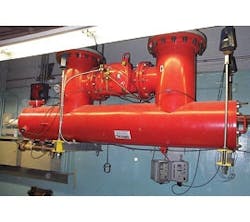When industry moves into a neighborhood, residents sometimes say, “Not in my backyard.” Jobs are great, an infusion to the local economy is great and ancillary businesses are great—“just don’t build it within sight of my yard.”
But the naysayers should look on the bright side. Most industry require cooling towers for their operations, and cooling towers, scrub pollen, insects, dust, debris and other allergens from the air throughout the surrounding community. So industry can be a good neighbor after all, if it helps alleviate your hay fever.
What is good for hay fever relief, however, often is the bane of industry maintenance personnel’s existence. A continuous stream of suspended solids entering the cooling water through the cooling tower means a nightmare of maintenance for heat exchangers, chillers, compressors, cooling jackets and spray nozzles—not to mention the sludge that develops in the cooling tower basin.
Overcoming Inefficiencies
Chemicals can help control biological growth and mineral precipitation, but only mechanical filtration can remove the suspended solids that cooling towers grab from the atmosphere each year. A thin layer of mineral deposits that may only have the thickness of a few sheets of paper can have deleterious effects on cooling efficiency. To overcome inefficiencies, more water has to be pumped, using more horsepower, which means higher utility costs and lower profits. If soray nozzles plug, maintenance personnel must physically remove and clean or replace nozzles by hand. Time and labor costs subtract from the bottom line. Automatic self-cleaning filters can solve most of these issues. Capital costs will be higher, but operational costs will be at a minimum and human error is taken out of the equation.
Two basic filtration systems most often are utilized for suspended solids removal. The first is side-stream filtration. When protecting heat exchangers, chillers, compressors and cooling jackets, this method is the most economical and still meets performance expectations. Typically, 5% to 15% of the full flow is pulled off the main line as a side-stream and run through a filter. As a general rule of thumb, 10% side-stream filtration will maintain the concentration of total suspended solids (TSS) at a steady low level to protect heat exchange surfaces from deposition. The percentage of full flow used in side-stream filtration will be determined by cooling system volume, TSS loading, filtration degree required and type of suspended solids. Sometimes it is desirable to pull the side-stream off the main header after the supply pump, filter the side-stream and reintroduce the filtered water into the main header. (See Figure 1.)
A booster pump will be necessary to add energy back to the side-stream flow to overcome system losses in the filtration process. These losses show up as pressure losses due to valves, piping, fittings, flow-stream directional changes and velocity losses.
If the main supply pump has excess capacity, the side-stream can be taken from the main header downstream of the pump, run through the filter and discharged back to the cooling tower basin. This utilizes existing horsepower and requires no booster pump. (See Figure 2.)
A third side-stream scenario, often called a kidney loop, uses a small dedicated pump to take water from the cooling tower basin and run it through the filter and back to the tower basin. (See Figure 3.) This system is totally independent from the main cooling system and cannot negatively interfere with the cooling process.
When nozzles are involved in the downstream process, a single particle of the right size could plug a nozzle. For full protection to prevent nozzle problems, full-flow filtration is necessary. This constitutes the second basic cooling tower filtration system. Figure 4 shows a full-flow schematic. A bypass often is incorporated into the filter installation so flow can be maintained to process in times of filter maintenance or repairs. This bypass can be manually or automatically activated. The filter controller can recognize a filter fault and automatically open a by-pass valve and send a warning signal to the operator. Even filters with a built-in automatic bypass system are available.
Case Study
A large Midwest pharmaceutical plant for animal vaccines and medications caters to cattle, swine, equine and companion animals such as cats and dogs. Highly sophisticated processes are utilized to produce pharmaceuticals, and cooling is a very important component of these processes. Plant engineers discovered that the small 400-gal-per-minute (gpm) side-stream four-bag filtration system on its 5,300-gpm cooling tower system did not provide the protection they needed for heat exchangers, condensers and vessel cooling jackets scattered throughout the facility, in addition to an 800-ton chiller.
A big design criterion is sufficient screen area to handle water quality conditions. The filter flux must be of appropriate value to meet the specific conditions of filtration degree, TSS loading and type of solids. Filter flux is defined as the flow rate per unit area of screen media; i.e., gal per minute per square inch of usable screen surface. Filters with a small footprint and large screen area were chosen to meet the specific demands of this application.
Five Orival Model ORG-080-LS automatic self-cleaning filters were mounted on a 16-in. manifold that included a blind flange. This enabled a sixth filter to be installed when a pre-scheduled cooling capacity increase was added in the future. A 16-in. pneumatically actuated bypass valve was incorporated into the manifold system to open automatically if the filtration system controller sensed a fault in the filtration process. The controller also has a set of dry contacts for connecting an alarm system for fault situations. An 8-in. manual butterfly valve was located at each filter inlet and outlet to allow the isolation of any individual filter for maintenance or repairs. The filters were pre-mounted on the manifold system before shipping to the site for ease of installation.
Prudent use of appropriate chemical additives, routine blow-down and proper filtration has resulted in six years of exemplary performance with no maintenance issues or process interruptions.
Download: Here



